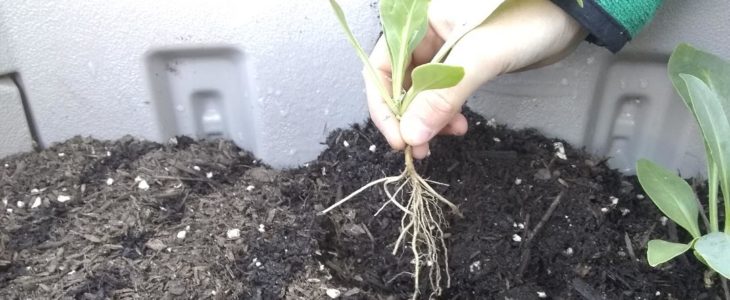
I confess: I made a trip to Lowe’s to buy a car-load of potting soil on Saturday instead of staying home. It was a chosen, precious outing to help solve a wonderful problem: we had run out of places for new planting projects. Kid 2 and Kid 3 have claimed the space inside the kids’ garden for strawberries, sunflowers, spreading primroses, and just plain digging. Kid 1 has in the last month and a half filled pots of many sizes and styles with agave pups, strawberry cuttings, wildflower transplants, potato eyes, and good ol’ seeds. Where could he plant next? 
Having my kids more actively engaged in gardening than usual during their COVID-19 school closure is a definite silver lining. Nature to You is honoring Earth Day by celebrating a new garden bed my son and I created this week from repurposed and recycled materials – most from our own home.
Repurposed storage box = raised bed
Until this Monday, the box housed a musty collection of off-season frost cloths, leaking fertilizer bottles, and a rolled up old rope ladder. Its lid was loose, typically blowing off during storms. Two to three bags of potting soil should fill it sufficiently… my son and I happily came to the same conclusion that this sturdy plastic container would answer our need for planting space. In the end, we didn’t even need that much store-bought soil because of what we had on hand.
Recycled yard scraps = hugelkultur 
Hugelkultur is roughly a method of using scrap wood as a garden bed base. The aeration and composting that occur underground support the new growth at the surface. An excuse to use stubborn sticks from my compost piles? Yes, please! We grabbed handfuls of wannabe compost and mounded it in the bottom of the new raised bed.
Recycled kitchen and yard scraps = compost
 See the roly poly? Under those barely decomposed sticks thrived an actual composting community. For at least a year in this particular pile, naturally occurring decomposers and water draining from the potted plants above (blog link) have turned scraps into soil. Recycled banana and orange peels, tea bags, pepper and apple cores, and wilted lettuce predominate from the kitchen. Recycled buggy broccoli, used potting soil, weedy brittlebush, slimy pond scum, and excess winter annuals (aka weeds) represent the backyard. My son and I shoveled our home-grown soil into the garden next. Rollie pollies and all.
See the roly poly? Under those barely decomposed sticks thrived an actual composting community. For at least a year in this particular pile, naturally occurring decomposers and water draining from the potted plants above (blog link) have turned scraps into soil. Recycled banana and orange peels, tea bags, pepper and apple cores, and wilted lettuce predominate from the kitchen. Recycled buggy broccoli, used potting soil, weedy brittlebush, slimy pond scum, and excess winter annuals (aka weeds) represent the backyard. My son and I shoveled our home-grown soil into the garden next. Rollie pollies and all.
Store-bought soil = top layer 
If I had a little more completed compost, this would have been the place for it. However, my other piles are still cooking. So this is where the Lowe’s purchase came in. Kid 1 and I scooped about 4 cubic feet of Kellogg’s brand soil atop the sticks and compost, then thoroughly enjoyed shaping the soft, moist material. Kid 3 wanted to take it out instead, so she got set up with extra soil over in the kids’ garden. Back in the new raised bed, Kid 1 designed a mini basin-and-berm system to support two watering zones: drought-tolerant and more thirsty.
Transplanted penstemon and globemallow = native plant showcase
Into 
 the drought-tolerant level he placed young penstemons. These prolific plants were the original inspiration for our new bed, because Kid 1 has been wanting to dig up and somehow use the many volunteers that sprang up this year from a three-year-old parent plant in the yard. Only last week had he also discovered volunteer globemallows nearby. He arranged those in front of the penstemon. In the process – as the garden teacher in me loves – he got to examine the roots of each plant and better understand the need for holes large enough to accommodate them.
the drought-tolerant level he placed young penstemons. These prolific plants were the original inspiration for our new bed, because Kid 1 has been wanting to dig up and somehow use the many volunteers that sprang up this year from a three-year-old parent plant in the yard. Only last week had he also discovered volunteer globemallows nearby. He arranged those in front of the penstemon. In the process – as the garden teacher in me loves – he got to examine the roots of each plant and better understand the need for holes large enough to accommodate them.
Cucumber starts = snacking garden
Did I mention I needed more space too? My two raised beds are currently full of both new summer veggies and lingering winter flowers. On top of that, I have pots of starts for Pima County Public Library classes that were cancelled, but the plants are ready for larger homes. So my son is kindly accommodating cucumbers in what he thought was his garden to plan. He likes cucumbers, so that helps. Three Armenian cucumber plants occupy the lower-tier, higher-water-use zone.
In a time of uncertainty and strangeness, this project and my son’s interest in it were sweetly satisfying. My trip to the store – normally no big deal – helped us get going. Pride in home-sourced plants, container, soil, and ideas helped make meaning. I’m pretty sure the chosen location for the new bed – ostensibly where the cucumbers will get good afternoon shade — has something to do with forts and hide-and-seek games too. That’s OK. Happy gardening and happy Earth Day, whatever meaning you make in your personal space.

